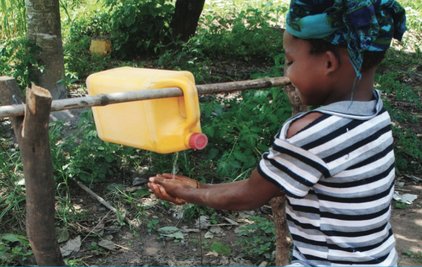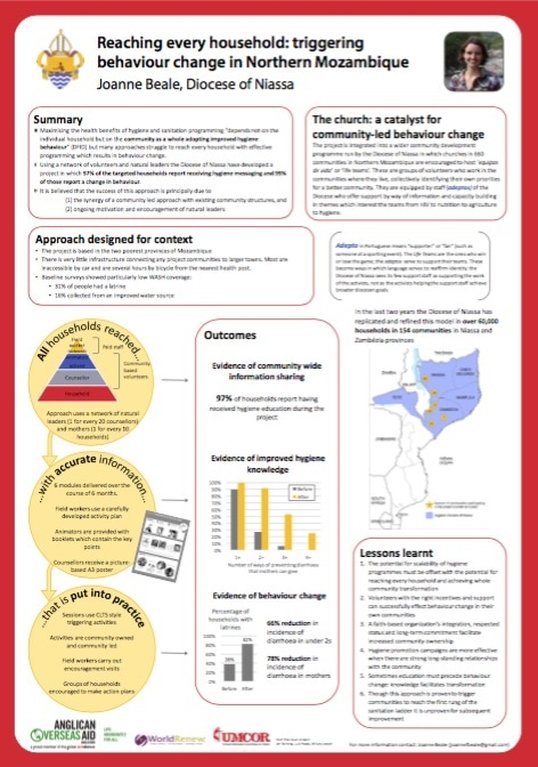 A girl uses a tippy tap to wash her hands
A girl uses a tippy tap to wash her hands Exciting results from a project to improve access to safe water, sanitation and hygiene across the Anglican Diocese of Niassa in northern Mozambique; it has proved extremely successful in generating significant behaviour change, according to the independent assessment.
And one of the reasons given for its success is the strength of the Church's links with the remote, rural communities which the project targeted.
The project built on 10 years of community work by the Diocese, says Joanne Beale, who led the project for the Diocese of Niassa. "The church's established and respected position in the local community means that that a longer term, transformative approach makes better use of the Diocese's strengths," she says.
Mozambique has one of the highest child mortality rates in the world: the national under five mortality rate is 90 deaths per 1000 live births, and the two provinces targeted by the project - Zambezi and Niassa - have some of the poorest water and sanitation coverage in the country. When the project started, knowledge of hygiene practices were very low. For example, in a survey of 328 households, 55% could not give any causes of diarrhoea and 48% listed ‘after defecating’ as a time that they washed their hands.
The project used existing Church structures, in particular community-based teams called Equipas de Vida, or Life Teams, to disseminate information and training via a cascading network of people. Made up of volunteers, the Equipas de Vida were originally created by congregations as part of the Church's HIV and AIDS programme. However, while an Equipa da Vida was an initial entry point, the programme functioned impartially, serving all members of a village irrelevant of religious belief, including Muslims, traditional beliefs and other Christian denominations.
The training methodology involved Adeptos (Diocesan staff members) training Animators (community-based volunteers, usually members of an Equipa da Vida), each of whom in turn trained ten Counsellors (also volunteers), who again transferred the information to 10 households. In this way, information was very effectively disseminated to the wider community. Training was given in six modules: 1) disease transmission, 2) hand washing, 3) storage and treatment of water, 4) latrines, 5) treatment of diarrhoea and 6) action plan.
The effectiveness of this training methodology meant a high proportion of community members retained the knowledge they had received, and community members all said there had been a reduction in infant mortality due to changed practices as a result of the education programme. The project was also effective because it built the capacity of natural leaders within a community to trigger behaviour change. It is now being scaled up to reach more communities.
Click on the poster below to find out more about the project.
And one of the reasons given for its success is the strength of the Church's links with the remote, rural communities which the project targeted.
The project built on 10 years of community work by the Diocese, says Joanne Beale, who led the project for the Diocese of Niassa. "The church's established and respected position in the local community means that that a longer term, transformative approach makes better use of the Diocese's strengths," she says.
Mozambique has one of the highest child mortality rates in the world: the national under five mortality rate is 90 deaths per 1000 live births, and the two provinces targeted by the project - Zambezi and Niassa - have some of the poorest water and sanitation coverage in the country. When the project started, knowledge of hygiene practices were very low. For example, in a survey of 328 households, 55% could not give any causes of diarrhoea and 48% listed ‘after defecating’ as a time that they washed their hands.
The project used existing Church structures, in particular community-based teams called Equipas de Vida, or Life Teams, to disseminate information and training via a cascading network of people. Made up of volunteers, the Equipas de Vida were originally created by congregations as part of the Church's HIV and AIDS programme. However, while an Equipa da Vida was an initial entry point, the programme functioned impartially, serving all members of a village irrelevant of religious belief, including Muslims, traditional beliefs and other Christian denominations.
The training methodology involved Adeptos (Diocesan staff members) training Animators (community-based volunteers, usually members of an Equipa da Vida), each of whom in turn trained ten Counsellors (also volunteers), who again transferred the information to 10 households. In this way, information was very effectively disseminated to the wider community. Training was given in six modules: 1) disease transmission, 2) hand washing, 3) storage and treatment of water, 4) latrines, 5) treatment of diarrhoea and 6) action plan.
The effectiveness of this training methodology meant a high proportion of community members retained the knowledge they had received, and community members all said there had been a reduction in infant mortality due to changed practices as a result of the education programme. The project was also effective because it built the capacity of natural leaders within a community to trigger behaviour change. It is now being scaled up to reach more communities.
Click on the poster below to find out more about the project.

 RSS Feed
RSS Feed
